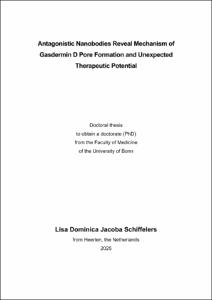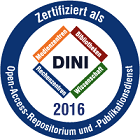Schiffelers, Lisa Dominica Jacoba: Antagonistic Nanobodies Reveal Mechanism of Gasdermin D Pore Formation and Unexpected Therapeutic Potential. - Bonn, 2025. - Dissertation, Rheinische Friedrich-Wilhelms-Universität Bonn.
Online-Ausgabe in bonndoc: https://nbn-resolving.org/urn:nbn:de:hbz:5-81782
Online-Ausgabe in bonndoc: https://nbn-resolving.org/urn:nbn:de:hbz:5-81782
@phdthesis{handle:20.500.11811/12980,
urn: https://nbn-resolving.org/urn:nbn:de:hbz:5-81782,
doi: https://doi.org/10.48565/bonndoc-540,
author = {{Lisa Dominica Jacoba Schiffelers}},
title = {Antagonistic Nanobodies Reveal Mechanism of Gasdermin D Pore Formation and Unexpected Therapeutic Potential},
school = {Rheinische Friedrich-Wilhelms-Universität Bonn},
year = 2025,
month = apr,
note = {Activation of various inflammasomes converges on the cleavage of gasdermin D (GSDMD) by pro-inflammatory caspases, followed by oligomerization of the N-terminal domain (GSDMDNT) and the assembly of pores penetrating target membranes. As methods for live cell investigations of the GSDMD pore formation process are limited, the order of conformational changes, oligomerization, and membrane insertion remained unclear. Moreover, specific inhibitors of GSDMD have not yet been identified.
To deal with these shortcomings, we raised twenty-three nanobodies (VHHs) specific for human GSDMD and created a large and diverse repertoire of tools to study and perturb GSDMD in living cells at a molecular level. We found that cytosolic expression of VHHGSDMD-1 or VHHGSDMD-2 specifically abrogates GSDMD-mediated pyroptosis and IL-1β release in macrophage-like cell lines and human primary macrophages. This could be thoroughly confirmed upon both NLRC4- and NLRP3-induced inflammasome activation, and also showed potential upon the activation of the non-canonical inflammasome as well as the AIM2 inflammasome.
Binding of the antagonistic nanobodies to GSDMDNT interferes with its oligomerization, while inflammasome assembly and GSDMD processing itself were not affected. The nanobody-stabilized monomers of GSDMDNT partitioned into the plasma membrane, suggesting that monomeric GSDMDNT is able to directly insert into the plasma membrane and build up the pore monomer by monomer within target membranes. The formation of pre-pores, i.e. oligomerization before membrane insertion, is thus no prerequisite for GSDMD pore formation.
Inhibition of GSDMD pore formation switches cell death from pyroptosis to apoptosis, which still required ASC specks and the activation of caspase-1. We propose a novel layer of regulation of the caspase-1 activity by GSDMD pores, as the enzymatic activity was substantially augmented in presence of the antagonistic nanobodies. Caspase-1 therefore seems to be the key regulator that activates apoptotic mediators such as caspase-3, caspase-7, caspase-8, caspase-9, and BID in the absence of GSDMD pores. GSDME cleavage was observed as well, but no GSDME-mediated pyroptosis could be detected.
Furthermore, we revealed the unexpected therapeutic potential of antagonistic GSDMD nanobodies, as recombinant nanobodies added to the extracellular space prevented inflammatory cell death. The nanobodies thereby enter through the first sublytic pores, after which they curtail the assembly of additional pores and prevent inflammatory cell death. GSDMD nanobodies may thus exhibit the features necessary to treat the evergrowing list of diseases caused by activation of (non-) canonical inflammasomes.},
url = {https://hdl.handle.net/20.500.11811/12980}
}
urn: https://nbn-resolving.org/urn:nbn:de:hbz:5-81782,
doi: https://doi.org/10.48565/bonndoc-540,
author = {{Lisa Dominica Jacoba Schiffelers}},
title = {Antagonistic Nanobodies Reveal Mechanism of Gasdermin D Pore Formation and Unexpected Therapeutic Potential},
school = {Rheinische Friedrich-Wilhelms-Universität Bonn},
year = 2025,
month = apr,
note = {Activation of various inflammasomes converges on the cleavage of gasdermin D (GSDMD) by pro-inflammatory caspases, followed by oligomerization of the N-terminal domain (GSDMDNT) and the assembly of pores penetrating target membranes. As methods for live cell investigations of the GSDMD pore formation process are limited, the order of conformational changes, oligomerization, and membrane insertion remained unclear. Moreover, specific inhibitors of GSDMD have not yet been identified.
To deal with these shortcomings, we raised twenty-three nanobodies (VHHs) specific for human GSDMD and created a large and diverse repertoire of tools to study and perturb GSDMD in living cells at a molecular level. We found that cytosolic expression of VHHGSDMD-1 or VHHGSDMD-2 specifically abrogates GSDMD-mediated pyroptosis and IL-1β release in macrophage-like cell lines and human primary macrophages. This could be thoroughly confirmed upon both NLRC4- and NLRP3-induced inflammasome activation, and also showed potential upon the activation of the non-canonical inflammasome as well as the AIM2 inflammasome.
Binding of the antagonistic nanobodies to GSDMDNT interferes with its oligomerization, while inflammasome assembly and GSDMD processing itself were not affected. The nanobody-stabilized monomers of GSDMDNT partitioned into the plasma membrane, suggesting that monomeric GSDMDNT is able to directly insert into the plasma membrane and build up the pore monomer by monomer within target membranes. The formation of pre-pores, i.e. oligomerization before membrane insertion, is thus no prerequisite for GSDMD pore formation.
Inhibition of GSDMD pore formation switches cell death from pyroptosis to apoptosis, which still required ASC specks and the activation of caspase-1. We propose a novel layer of regulation of the caspase-1 activity by GSDMD pores, as the enzymatic activity was substantially augmented in presence of the antagonistic nanobodies. Caspase-1 therefore seems to be the key regulator that activates apoptotic mediators such as caspase-3, caspase-7, caspase-8, caspase-9, and BID in the absence of GSDMD pores. GSDME cleavage was observed as well, but no GSDME-mediated pyroptosis could be detected.
Furthermore, we revealed the unexpected therapeutic potential of antagonistic GSDMD nanobodies, as recombinant nanobodies added to the extracellular space prevented inflammatory cell death. The nanobodies thereby enter through the first sublytic pores, after which they curtail the assembly of additional pores and prevent inflammatory cell death. GSDMD nanobodies may thus exhibit the features necessary to treat the evergrowing list of diseases caused by activation of (non-) canonical inflammasomes.},
url = {https://hdl.handle.net/20.500.11811/12980}
}





